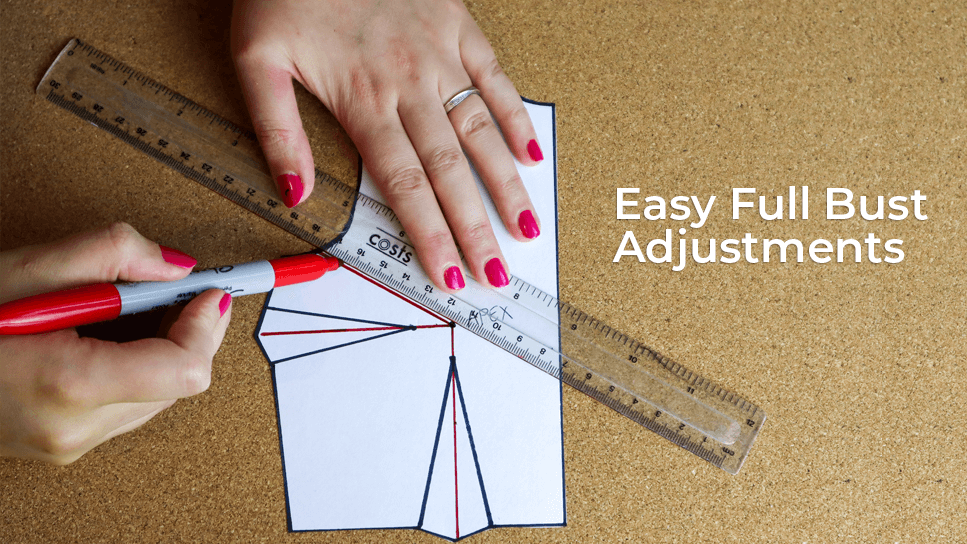
Full Bust Adjustment – double darted bodice

Follow our step-by-step guide to adding a full bust adjustment (FBA) to a double darted bodice. We’ll show you how to work out if you need an FBA, how much you should add and importantly how to alter your pattern pieces.
DO I NEED AN FBA?
Just as your figure changes, so does the position of your bust point (apex). If your garment wrinkles above or below the bust, it is an indication that the bust darts are not working correctly for your shape. Also if your pattern doesn’t include separate pattern pieces for custom cup sizes, then the pattern is designed for a figure with a size B bra cup – this is the base size we use to design the rest of our patterns. If you are larger or smaller than that size then an adjustment is likely to be required.
First, you need to determine where your bust point is positioned in relation to the pattern. All our patterns have a marking on the tissue for the bust point, indicated by a large circle with a cross inside. Hold the pattern piece up against your body, placing the shoulder stitching line where it would sit on your shoulder, and keeping the tissue’s centre front at the centre of your body. If the bust point marking does not fall at the apex (point) of your bust, you will need to make an adjustment.
Another way to know before even choosing a pattern size is using your body measurements. In our handy measuring guide and video we show you how to measure you bust (around your ribcage across the bust apex) and high bust (aka the upper bust, basically the chest circumference above your bust). If you have a large bust for your frame and choose a pattern size based on your bust measurement you may find the finished garment falls off your shoulder. So what do you do…? You work out the difference between your full bust and high bust. If your full bust measurement is bigger than your high bust by more than 2.5” (6.5cm) use your high bust measurement to pick your pattern size and then do an FBA.

Why not try this tutorial on New Look 6262.
HOW BIG SHOULD MY FULL BUST ADJUSTMENT BE?
There’s no exact science to measure how much of a bust adjustment you’ll need as it depends on your fabric and whether you’re making a loose-fitting garment. That’s why making toiles as practice garments aka muslins is so helpful.
This chart should show how you work out the difference between your bust measurements and find your FBA amount.
| Full bust measurement | 36″ | 91.4cm |
| High bust measurement | 33″ | 83.8cm |
| Difference | 3″ | 7.6cm |
| FBA amount | 1.5″ | 3.8cm |
MAKING THE ADJUSTMENT
The full and small bust technique was developed and originally published in Fit For Real People by Pati Palmer and Marta Alto. This incredible book is a must read if you want to learn about a range of fitting fixes.
Step 1: Draw a line up through the centre of the waist dart up to the apex point.

Step 2: Draw a line through the centre of the bust dart to the apex point.

Step 3: Draw a line from the apex out to 1/3 of the way up the armhole.

You’ll have these three lines when you’re finished.

Step 4: Cut along the lines, leaving the paper connected at the armhole and the end of the bust dart as shown. You’re making two little hinges of paper.

Step 5: Now you can pivot the pieces to create space. Spread the paper by pulling the lower left side away, keeping the vertical lines parallel. Measure between the two vertical lines so they are the required amount apart.

Step 6: Cut into the centre front edge at 90 degrees and move down to match the new length.

Step 7: Find the new apex by drawing along the dart centres until as you did before, finding the point where the two lines meet.

Step 8: Measure 1″ down each line away from the apex. Mark each point and redraw the dart legs for the bust and waist darts. Then close the gap in the centre front edge.

Step 9: You’ve finished! You’ve now added extra space to the bust area but when sewn the waist and side seams will be the same lengths as before you began your adjustments. This focusses the new space just where you need it! If you wish you can trace a fresh copy of your front bodice piece to avoid any confusion.
